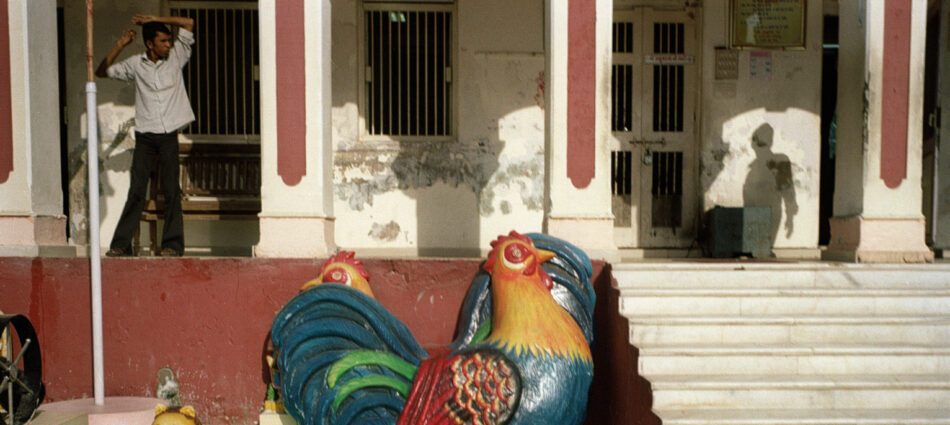
Continuing The Search For The Female Sufi Saints And Finding The Business Of The Blessing
The evidence of new money from the Gulf is vividly evident at the shrine of the female warrior saind Beema Biwi. It is evident in the large, ostentatious and garishly pink structure that now surrounds what was once a small shrine.
Donations have helped transform this remote shrine located near the ocean front and directly in the parth of jet aircrafts landing a Trivandrum airport into perhaps one of the most well known and powerful shrines in the state of Kerala. The influence is also evident in the large market filled with smuggled and contraband consumer goods from the Gulf states. WIth stores sporting signs such as Al-Haj cosmetics, Dubai Electronics, and Medina Traders the market is a uniquely modern version of the markets that traditionally welcome devotees to shrine.
Where one would expect to numerous small stalls selling garlands of roses, prayer mats, devotional chadors (sheets), sweet meats, music videos and CDs celebrating the life of the saint, here one can find cheap, Chinese copies of the essentials of ‘the good life’ – washing machines, CD players, mobile phones, microwave ovens, flat screen televisions and much else. I could not find a flower seller but a number of touts offered to sell me pirated copies of the latest Hollywood blockbusters.
The reasons for the absence of such vendors of devotional goods became evident to me once I stepped into the shrine and realized that devotees are no longer able to approach the tomb of the saint, and neither would the caretakees entertain the draping of the coffin with a devotional chador or garlands of flowers. The tomb itself today lies hidden behind a curtain which is only pulled apart when a devotee steps up to receive a blessing. Otherwise the curtains are pulled closed. A huge hall, complete with lotus topped pillars, surrounds the sanctum of the shrine, and devotees can be seeing resting, prayer, sleeping and generally milling about inside. There is an austere atmosphere here, and one of the least welcoming that I have experienced in a shrine. The imposing architecture, the surly caretakers and the perfunctory nature with which the blessings and rituals seem to be performed leaves one feeling uncomfortable hanging about.
There are two tombs inside this shrine – one to Beema Biwi and alongside it another to her son, Abu Bakr. The two were martyred in a battlesome 500 years ago it seems, but few seem to know what the battle was about and against whom. I suspect that the dates of their arrival in India and martyrdom are also not accurate. This seems quite typical of the legend of the saints in the area: their stories are largely forgotten and their past seems to hold no real importance for both the families that maintain and care for the shrines and the devotees who come here seeking solace, salvation and blessings. Just outside the main shrine is another mausoleum – this one to a saint called Mastan Baba. Built sometime in the 1980s the shrine is to a wandering mystic whose history and real name are unknown.
Dominique Sila-Khan, in her work Sacred Kerala: A Spiritual Pilgrimage describes how many of the rituals performed at the Beema Biwi complex echo rituals typically associated with worshop and devotion at Hindu temples. The viewing of the sacred sanctum containing the tombs of Beema Biwi and her son Abu Bakr is called didar a persian word for ‘the blessed glimpse’ and whose equivalent may be the Hindi word darshan. During the annual Chandanakuda mahotsavam festival devotees bring clay and earthen pots, also known as kudans, which have been smeared with chandanam, sandalwood paste, and filled with coins. These can often be seen lying close to the tombs themselves. The tombs are frequently washed and the blessed water offered to devotees – an act quite similar to amrit a ritual typically associated with practices in Sikh temples.
The female saints of Kerala are a powerful influence here for people of all faiths. I had earlier written about the shrine of Manubam Bibi located on the shores close to the Keralan town of Ponnani. Just as there at the ocean front shrine of Manubam Bibi, people of all faiths congregate here in this imposing shrine of Beema Biwi. The shrine today is overtly Islamic but it is clear that the influence, and power of these saints transcends the borders of orthodox faith and sectarian divisions. It was difficult not to see the grandiose architecture of the shrine as an attempt to take control of the Biwi and bring her into the fold of an acceptable and palatable Islamic heritage. As if sheer scale would be enough to claim the right to her power, her meaning, her heritage and her power. The thousands who come here however seem oblivious to these material designs, and quietly go about in their many religious ways and methods of sitting at her feet and asking for her blessings. The remnants of her original, simpler shrine can still be seen under the dome of the new structure. Someone its humble appearance seemed more in keeping with the idea of a woman who traveled here from Arabia and died in the path of faith. The new, garish, and frankly tacky structure seems to want to veil the materialism that now pervades this entire complex and impress upon the faithful that piety is best expressed through power and privilege of wealth. The cold, dismissive attitude of the caretakers, the thriving consumer goods markets, the rather touristy atmosphere, distract from the meaning of the pilgrimage to this shrine. Here, much as I have felt at some other important shrines in India, blessings have become a business.

